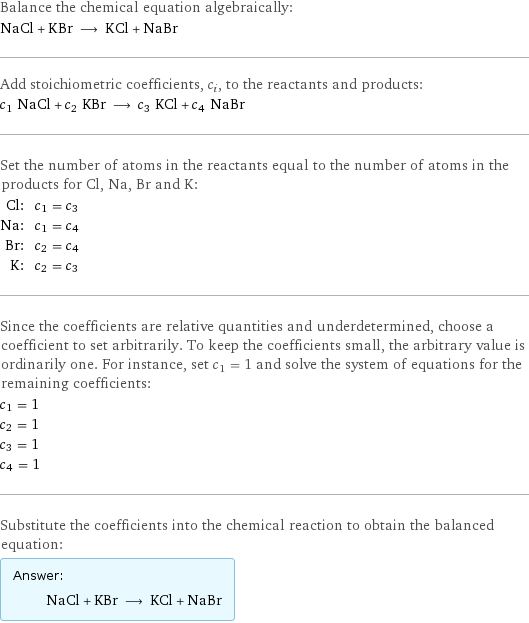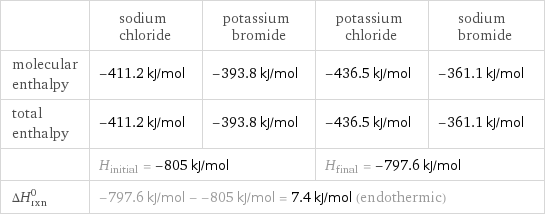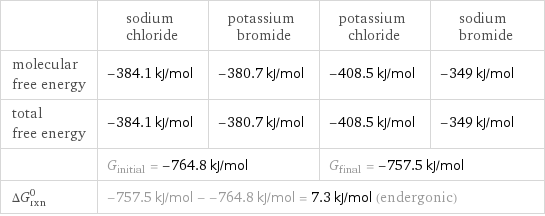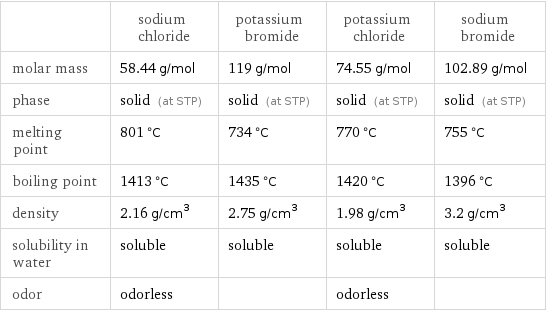Input interpretation

NaCl sodium chloride + KBr potassium bromide ⟶ KCl potassium chloride + NaBr sodium bromide
Balanced equation

Balance the chemical equation algebraically: NaCl + KBr ⟶ KCl + NaBr Add stoichiometric coefficients, c_i, to the reactants and products: c_1 NaCl + c_2 KBr ⟶ c_3 KCl + c_4 NaBr Set the number of atoms in the reactants equal to the number of atoms in the products for Cl, Na, Br and K: Cl: | c_1 = c_3 Na: | c_1 = c_4 Br: | c_2 = c_4 K: | c_2 = c_3 Since the coefficients are relative quantities and underdetermined, choose a coefficient to set arbitrarily. To keep the coefficients small, the arbitrary value is ordinarily one. For instance, set c_1 = 1 and solve the system of equations for the remaining coefficients: c_1 = 1 c_2 = 1 c_3 = 1 c_4 = 1 Substitute the coefficients into the chemical reaction to obtain the balanced equation: Answer: | | NaCl + KBr ⟶ KCl + NaBr
Structures

+ ⟶ +
Names

sodium chloride + potassium bromide ⟶ potassium chloride + sodium bromide
Reaction thermodynamics
Enthalpy

| sodium chloride | potassium bromide | potassium chloride | sodium bromide molecular enthalpy | -411.2 kJ/mol | -393.8 kJ/mol | -436.5 kJ/mol | -361.1 kJ/mol total enthalpy | -411.2 kJ/mol | -393.8 kJ/mol | -436.5 kJ/mol | -361.1 kJ/mol | H_initial = -805 kJ/mol | | H_final = -797.6 kJ/mol | ΔH_rxn^0 | -797.6 kJ/mol - -805 kJ/mol = 7.4 kJ/mol (endothermic) | | |
Gibbs free energy

| sodium chloride | potassium bromide | potassium chloride | sodium bromide molecular free energy | -384.1 kJ/mol | -380.7 kJ/mol | -408.5 kJ/mol | -349 kJ/mol total free energy | -384.1 kJ/mol | -380.7 kJ/mol | -408.5 kJ/mol | -349 kJ/mol | G_initial = -764.8 kJ/mol | | G_final = -757.5 kJ/mol | ΔG_rxn^0 | -757.5 kJ/mol - -764.8 kJ/mol = 7.3 kJ/mol (endergonic) | | |
Equilibrium constant
![Construct the equilibrium constant, K, expression for: NaCl + KBr ⟶ KCl + NaBr Plan: • Balance the chemical equation. • Determine the stoichiometric numbers. • Assemble the activity expression for each chemical species. • Use the activity expressions to build the equilibrium constant expression. Write the balanced chemical equation: NaCl + KBr ⟶ KCl + NaBr Assign stoichiometric numbers, ν_i, using the stoichiometric coefficients, c_i, from the balanced chemical equation in the following manner: ν_i = -c_i for reactants and ν_i = c_i for products: chemical species | c_i | ν_i NaCl | 1 | -1 KBr | 1 | -1 KCl | 1 | 1 NaBr | 1 | 1 Assemble the activity expressions accounting for the state of matter and ν_i: chemical species | c_i | ν_i | activity expression NaCl | 1 | -1 | ([NaCl])^(-1) KBr | 1 | -1 | ([KBr])^(-1) KCl | 1 | 1 | [KCl] NaBr | 1 | 1 | [NaBr] The equilibrium constant symbol in the concentration basis is: K_c Mulitply the activity expressions to arrive at the K_c expression: Answer: | | K_c = ([NaCl])^(-1) ([KBr])^(-1) [KCl] [NaBr] = ([KCl] [NaBr])/([NaCl] [KBr])](../image_source/fec4c5b714be9fec1fd2ed7f6552b02f.png)
Construct the equilibrium constant, K, expression for: NaCl + KBr ⟶ KCl + NaBr Plan: • Balance the chemical equation. • Determine the stoichiometric numbers. • Assemble the activity expression for each chemical species. • Use the activity expressions to build the equilibrium constant expression. Write the balanced chemical equation: NaCl + KBr ⟶ KCl + NaBr Assign stoichiometric numbers, ν_i, using the stoichiometric coefficients, c_i, from the balanced chemical equation in the following manner: ν_i = -c_i for reactants and ν_i = c_i for products: chemical species | c_i | ν_i NaCl | 1 | -1 KBr | 1 | -1 KCl | 1 | 1 NaBr | 1 | 1 Assemble the activity expressions accounting for the state of matter and ν_i: chemical species | c_i | ν_i | activity expression NaCl | 1 | -1 | ([NaCl])^(-1) KBr | 1 | -1 | ([KBr])^(-1) KCl | 1 | 1 | [KCl] NaBr | 1 | 1 | [NaBr] The equilibrium constant symbol in the concentration basis is: K_c Mulitply the activity expressions to arrive at the K_c expression: Answer: | | K_c = ([NaCl])^(-1) ([KBr])^(-1) [KCl] [NaBr] = ([KCl] [NaBr])/([NaCl] [KBr])
Rate of reaction
![Construct the rate of reaction expression for: NaCl + KBr ⟶ KCl + NaBr Plan: • Balance the chemical equation. • Determine the stoichiometric numbers. • Assemble the rate term for each chemical species. • Write the rate of reaction expression. Write the balanced chemical equation: NaCl + KBr ⟶ KCl + NaBr Assign stoichiometric numbers, ν_i, using the stoichiometric coefficients, c_i, from the balanced chemical equation in the following manner: ν_i = -c_i for reactants and ν_i = c_i for products: chemical species | c_i | ν_i NaCl | 1 | -1 KBr | 1 | -1 KCl | 1 | 1 NaBr | 1 | 1 The rate term for each chemical species, B_i, is 1/ν_i(Δ[B_i])/(Δt) where [B_i] is the amount concentration and t is time: chemical species | c_i | ν_i | rate term NaCl | 1 | -1 | -(Δ[NaCl])/(Δt) KBr | 1 | -1 | -(Δ[KBr])/(Δt) KCl | 1 | 1 | (Δ[KCl])/(Δt) NaBr | 1 | 1 | (Δ[NaBr])/(Δt) (for infinitesimal rate of change, replace Δ with d) Set the rate terms equal to each other to arrive at the rate expression: Answer: | | rate = -(Δ[NaCl])/(Δt) = -(Δ[KBr])/(Δt) = (Δ[KCl])/(Δt) = (Δ[NaBr])/(Δt) (assuming constant volume and no accumulation of intermediates or side products)](../image_source/481b04c3e4c6eef200f3ac8c1308fd54.png)
Construct the rate of reaction expression for: NaCl + KBr ⟶ KCl + NaBr Plan: • Balance the chemical equation. • Determine the stoichiometric numbers. • Assemble the rate term for each chemical species. • Write the rate of reaction expression. Write the balanced chemical equation: NaCl + KBr ⟶ KCl + NaBr Assign stoichiometric numbers, ν_i, using the stoichiometric coefficients, c_i, from the balanced chemical equation in the following manner: ν_i = -c_i for reactants and ν_i = c_i for products: chemical species | c_i | ν_i NaCl | 1 | -1 KBr | 1 | -1 KCl | 1 | 1 NaBr | 1 | 1 The rate term for each chemical species, B_i, is 1/ν_i(Δ[B_i])/(Δt) where [B_i] is the amount concentration and t is time: chemical species | c_i | ν_i | rate term NaCl | 1 | -1 | -(Δ[NaCl])/(Δt) KBr | 1 | -1 | -(Δ[KBr])/(Δt) KCl | 1 | 1 | (Δ[KCl])/(Δt) NaBr | 1 | 1 | (Δ[NaBr])/(Δt) (for infinitesimal rate of change, replace Δ with d) Set the rate terms equal to each other to arrive at the rate expression: Answer: | | rate = -(Δ[NaCl])/(Δt) = -(Δ[KBr])/(Δt) = (Δ[KCl])/(Δt) = (Δ[NaBr])/(Δt) (assuming constant volume and no accumulation of intermediates or side products)
Chemical names and formulas

| sodium chloride | potassium bromide | potassium chloride | sodium bromide formula | NaCl | KBr | KCl | NaBr Hill formula | ClNa | BrK | ClK | BrNa name | sodium chloride | potassium bromide | potassium chloride | sodium bromide
Substance properties

| sodium chloride | potassium bromide | potassium chloride | sodium bromide molar mass | 58.44 g/mol | 119 g/mol | 74.55 g/mol | 102.89 g/mol phase | solid (at STP) | solid (at STP) | solid (at STP) | solid (at STP) melting point | 801 °C | 734 °C | 770 °C | 755 °C boiling point | 1413 °C | 1435 °C | 1420 °C | 1396 °C density | 2.16 g/cm^3 | 2.75 g/cm^3 | 1.98 g/cm^3 | 3.2 g/cm^3 solubility in water | soluble | soluble | soluble | soluble odor | odorless | | odorless |
Units
